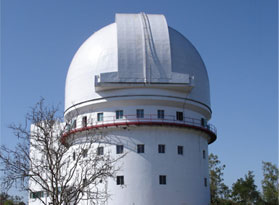
During September of 2014, Dr. Bryan Penprase and Dr. Barney Bate, assisted by Rector Sarah Weiss, offered the Yale-NUS College students a “Week 7” experiential learning course entitled “Culture and Cosmology in the Cōḻa World.”
Our group of 14 Yale-NUS College students on the Culture and Cosmology in the Cōḻa World trip explored Hindu temples and art by day and by night peered into the clear, dark skies of central Tamilnadu as we contemplated the evolution of Indian cosmology over several thousand years.
In the trip, we explored one of the richest of India’s ancient cultures and their approach to the universe – its spatial and temporal origins and the cosmology and structure of the universe. The joining of cosmology and architecture is motivated by the temples and their place in the Cōḻa world, c. 9th-13th CE. The three temples that we visited around Thanjavur are stunning works of architecture in and of themselves. They are also cosmographic diagrams, images of the designers’ understanding of the universe, their Lord Śiva, and our relationship to Eternity. Everything about these temples – their layout on an East-West axis, the centering of structure on the deity, and the intricate carvings of stories about Lord Siva and his saints – was designed to provide the worshipper with an image and understanding of the universe and our location within it. We spent four days probing their understanding of these temples through extensive site visits, lectures by local experts, and readings.
The trip also explored how the vision of the universe embodied in these temples inspired one of the greatest traditions of astronomy in the world. Cosmology was a preoccupation of Indians over the millennia. India invented many key concepts by which we have understood our universe from ancient times to the modern cosmological paradigm of astrophysics. A favorite image of the Cōḻa period is of the Lord Śiva, or Naṭarājah, the Dancing Lord, depicted during his eternal dance of creation and destruction of the universe. This vision was contemplated by Tamil Śaivaites for several millennia and later refined into models of astrophysics by later descendants of this culture, such as Nobel laureate Subrahmanyan Chandrasekhar. Chandrasekhar’s contributions to astrophysics include the discovery of the theory of collapse stars known as white dwarfs and new theories of general relativity that have helped advance modern cosmology.

Our deep contemplation of the origins of the universe, space, and time included visiting one of the most modern Indian observatories, the Vainu Bappu Observatory, which features a 2.3-meter telescope and some of the best spectrographs in the world. With such spectrographs, astronomers have divided light into its component wavelengths to measure the universe’s expansion and the elements in stars and galaxies thousands and millions of light years away. At the observatory, we discussed the universe’s origins, as described by astrophysics, with many contributions from Indian astronomers and astrophysicists.
Throughout the trip, we included sky viewing through portable telescopes and on the sites of the most important temples to contemplate the evolution of Indian sciences of astronomy and their contributions to the larger cosmology that emerged in the twentieth century, which describes our origin from an early universe of particles and forces that ultimately expands and cools to create the earth, stars, and people of today.
M33, Triangulum_Galaxy. Newton 10″ Telescope. Source: Wikimedia


